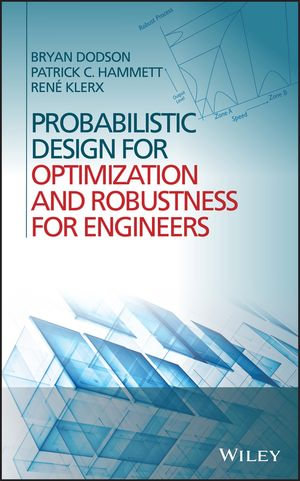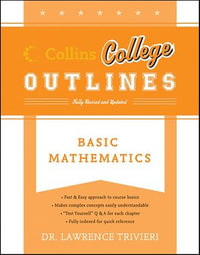
Probabilistic Design for Optimization and Robustness for Engineers
By: Bryan Dodson, Patrick Hammett, Rene Klerx
eText | 21 July 2014 | Edition Number 1
At a Glance
ePUB
eText
$124.29
or 4 interest-free payments of $31.07 with
orInstant online reading in your Booktopia eTextbook Library *
Read online on
Not downloadable to your eReader or an app
Why choose an eTextbook?
Instant Access *
Purchase and read your book immediately
Read Aloud
Listen and follow along as Bookshelf reads to you
Study Tools
Built-in study tools like highlights and more
* eTextbooks are not downloadable to your eReader or an app and can be accessed via web browsers only. You must be connected to the internet and have no technical issues with your device or browser that could prevent the eTextbook from operating.
Probabilistic Design for Optimization and Robustness:
- Presents the theory of modeling with variation using physical models and methods for practical applications on designs more insensitive to variation.
- Provides a comprehensive guide to optimization and robustness for probabilistic design.
- Features examples, case studies and exercises throughout.
The methods presented can be applied to a wide range of disciplines such as mechanics, electrics, chemistry, aerospace, industry and engineering. This text is supported by an accompanying website featuring videos, interactive animations to aid the readers understanding.
Read online on
Preface ix
Acknowledgments xi
1 New product development process 1
1.1 Introduction 1
1.2 Phases of new product development 2
1.2.1 Phase I-concept planning 3
1.2.2 Phase II-product planning 4
1.2.3 Phase III-product engineering design and verification 6
1.2.4 Phase IV-process engineering 9
1.2.5 Phase V-manufacturing validation and ramp-up 10
1.3 Patterns of new product development 11
1.4 New product development and Design for Six Sigma 13
1.4.1 DfSS core objectives 13
1.4.2 DfSS methodology 15
1.4.3 Embedded DfSS 16
1.5 Summary 17
Exercises 17
2 Statistical background for engineering design 19
2.1 Expectation 19
2.2 Statistical distributions 24
2.2.1 Normal distribution 24
2.2.2 Lognormal distribution 27
2.2.3 Weibull distribution 30
2.2.4 Exponential distribution 32
2.3 Probability plotting 34
2.3.1 Probability plotting-lognormal distribution 35
2.3.2 Probability plotting-normal distribution 36
2.3.3 Probability plotting-Weibull distribution 37
2.3.4 Probability plotting-exponential distribution 39
2.3.5 Probability plotting with confidence limits 40
2.4 Summary 43
Exercises 44
3 Introduction to variation in engineering design 46
3.1 Variation in engineering design 46
3.2 Propagation of error 47
3.3 Protecting designs against variation 48
3.4 Estimates of means and variances of functions of several variables 51
3.5 Statistical bias 59
3.6 Robustness 59
3.7 Summary 60
Exercises 61
4 Monte Carlo simulation 63
4.1 Determining variation of the inputs 63
4.2 Random number generators 64
4.3 Validation 66
4.4 Stratified sampling 70
4.5 Summary 74
Exercises 75
5 Modeling variation of complex systems 76
5.1 Approximating the mean, bias, and variance 77
5.2 Estimating the parameters of non-normal distributions 81
5.3 Limitations of first-order Taylor series approximation for variance 84
5.4 Effect of non-normal input distributions 91
5.5 Nonconstant input standard deviation 93
5.6 Summary 93
Exercises 95
6 Desirability 98
6.1 Introduction 98
6.2 Requirements and scorecards 99
6.2.1 Types of requirements 100
6.2.2 Design scorecard 101
6.3 Desirability-single requirement 103
6.3.1 Desirability-one-sided limit 104
6.3.2 Desirability-two-sided limit 106
6.3.3 Desirability-nonlinear function 107
6.4 Desirability-multiple requirements 109
6.4.1 Maxi-min total desirability index 114
6.5 Desirability-accounting for variation 115
6.5.1 Determining desirability-using expected yields 115
6.5.2 Determining desirability-using non-mean responses 116
6.6 Summary 118
Exercises 118
7 Optimization and sensitivity 123
7.1 Optimization procedure 123
7.2 Statistical outliers 128
7.3 Process capability 129
7.4 Sensitivity and cost reduction 133
7.4.1 Reservoir flow example 134
7.4.2 Reservoir flow initial solution 135
7.4.3 Reservoir flow initial solution verification 136
7.4.4 Reservoir flow optimized with normal horsepower distribution 138
7.4.5 Reservoir flow optimized with normal horsepower distribution verification 140
7.4.6 Reservoir flow horsepower variation sensitivity 141
7.4.7 Reservoir flow horsepower lognormal probability plot 143
7.4.8 Reservoir flow horsepower Cpk optimization using a lognormal distribution 144
7.5 Summary 149
Exercises 150
8 Modeling system cost and multiple outputs 153
8.1 Optimizing for total system cost 153
8.2 Multiple outputs 158
8.2.1 Optimization 159
8.2.2 Computing nonconformance 159
8.3 Large-scale systems 164
8.4 Summary 166
Exercises 167
9 Tolerance analysis 170
9.1 Introduction 170
9.2 Tolerance analysis methods 174
9.2.1 Historical tolerancing 174
9.2.2 Worst-case tolerancing 175
9.2.3 Statistical tolerancing 175
9.3 Tolerance allocation 178
9.4 Drift, shift, and sorting 179
9.5 Non-normal inputs 182
9.6 Summary 182
Exercises 182
10 Empirical model development 185
10.1 Screening 185
10.2 Response surface 193
10.2.1 Central composite designs 194
10.3 Taguchi 200
10.4 Summary 200
Exercises 201
11 Binary logistic regression 202
11.1 Introduction 202
11.2 Binary logistic regression 205
11.2.1 Types of logistic regression 205
11.2.2 Binary versus ordinary least squares regression 206
11.2.3 Binary logistic regression and the logit model 208
11.2.4 Binary logistic regression with multiple predictors 211
11.2.5 Binary logistic regression and sample size planning 211
11.2.6 Binary logistic regression fuel door example 212
11.2.7 Binary logistic regression-significant binary input 213
11.2.8 Binary logistic regression-nonsignificant binary input 214
11.2.9 Binary logistic regression-continuous input 214
11.2.10 Binary logistic regression-multiple inputs 215
11.3 Logistic regression and customer loss functions 217
11.4 Loss function with maximum (or minimum) response 220
11.5 Summary 223
Exercises 223
12 Verification and validation 225
12.1 Introduction 225
12.2 Engineering model V&V 228
12.3 Design verification methods and tools 230
12.3.1 Design verification reviews 230
12.3.2 Virtual prototypes and simulation 231
12.3.3 Physical prototypes and early production builds 232
12.3.4 Confirmation testing comparing alternatives 232
12.3.5 Confirmation tests comparing the design to acceptance criteria 233
12.4 Process validation procedure 233
12.5 Summary 238
References 239
Bibliography 242
Answers to selected exercises 246
Index 251
ISBN: 9781118796306
ISBN-10: 1118796306
Published: 21st July 2014
Format: ePUB
Language: English
Audience: Professional and Scholarly
Publisher: Wiley Professional Development (P&T)
Country of Publication: GB
Edition Number: 1
You Can Find This eBook In

eBOOK
eBook
$9.99

eBOOK
RRP $28.59
$22.99
OFF

eBOOK
RRP $43.99
$35.99
OFF

eBOOK
RRP $24.19
$19.99
OFF

eBOOK
$18.99

eBOOK
RRP $9.89
$8.99

eBOOK
RRP $28.59
$22.99
OFF

eBOOK
RRP $24.19
$19.99
OFF

eBOOK
RRP $13.19
$10.99
OFF

eBOOK
A Beginner's Guide to Constructing the Universe
The Mathematical Archetypes of Nature, Art, and Science
eBook
RRP $39.59
$31.99
OFF

eBOOK
$148.95












